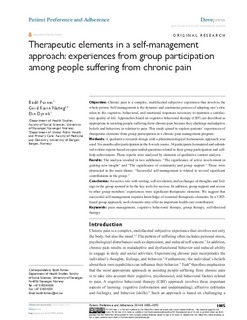| dc.contributor.author | Furnes, Bodil | |
| dc.contributor.author | Natvig, Gerd Karin | |
| dc.contributor.author | Dysvik, Elin | |
| dc.date.accessioned | 2015-07-28T12:18:47Z | |
| dc.date.accessioned | 2015-11-23T15:14:34Z | |
| dc.date.available | 2015-07-28T12:18:47Z | |
| dc.date.available | 2015-11-23T15:14:34Z | |
| dc.date.issued | 2014-08 | |
| dc.identifier.citation | Furnes, B., Natvig, G.K & Dysvik, E. (2014) Therapeutic elements in a self-management approach: experiences from group participation among people suffering from chronic pain. Patient Preference and Adherence 2014, 8:1085-1092 | nb_NO |
| dc.identifier.issn | 1177-889X | |
| dc.identifier.uri | http://hdl.handle.net/11250/2365363 | |
| dc.description | The article was originally published by Dove Press in Patient Preference and Adherence. See DOI:10.2147/PPA.S68046. | nb_NO |
| dc.description.abstract | Objective: Chronic pain is a complex, multifaceted subjective experience that involves the whole person. Self-management is the dynamic and continuous process of adapting one’s situation to the cognitive, behavioral, and emotional responses necessary to maintain a satisfactory quality of life. Approaches based on cognitive behavioral therapy (CBT) are described as appropriate in assisting people suffering from chronic pain because they challenge maladaptive beliefs and behaviors in relation to pain. This study aimed to explore patients’ experiences of therapeutic elements from group participation in a chronic pain management program.
Methods: A qualitative research design with a phenomenological hermeneutic approach was used. Six months after participation in the 8-week course, 34 participants formulated and submitted written reports based on open-ended questions related to their group participation and self-help achievement. These reports were analyzed by elements of qualitative content analysis.
Results: The analysis resulted in two subthemes: “The significance of active involvement in gaining new insight” and “The significance of community and group support.” These were abstracted in the main theme: “Successful self-management is related to several significant contributions in the group.”
Conclusion: An active role with writing, self-revelation, and exchanges of thoughts and feelings in the group seemed to be the key tools for success. In addition, group support and access to other group members’ experiences were significant therapeutic elements. We suggest that successful self-management requires knowledge of essential therapeutic elements. In a CBT-based group approach, such elements may offer an important health care contribution.
Keywords: pain management, cognitive behavioral therapy, group therapy, self-directed therapy | nb_NO |
| dc.language.iso | eng | nb_NO |
| dc.rights | Navngivelse 3.0 Norge | * |
| dc.rights.uri | http://creativecommons.org/licenses/by/3.0/no/ | * |
| dc.subject | kronisk smerte | nb_NO |
| dc.subject | self-management | nb_NO |
| dc.subject | CBT | nb_NO |
| dc.subject | cognitive behavioral therapy | nb_NO |
| dc.subject | gruppeterapi | nb_NO |
| dc.title | Therapeutic elements in a self-management approach: Experiences from group participation among people suffering from chronic pain | nb_NO |
| dc.type | Journal article | nb_NO |
| dc.type | Peer reviewed | nb_NO |
| dc.date.updated | 2015-07-28T12:18:47Z | |
| dc.subject.nsi | VDP::Medical disciplines: 700::Health sciences: 800 | nb_NO |
| dc.source.pagenumber | 1085–1092 | nb_NO |
| dc.source.volume | 8 | nb_NO |
| dc.source.journal | Patient Preference and Adherence | nb_NO |
| dc.identifier.doi | 10.2147/PPA.S68046 | |
| dc.identifier.cristin | 1163645 | |

